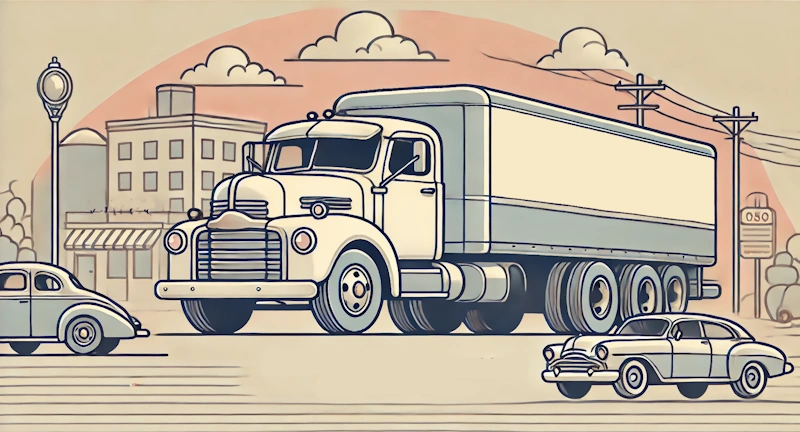Home » Becoming a Truck Driver
Becoming a Truck Driver
Becoming a Truck Driver
Truck driving is one of the oldest and most reliable careers, even in the toughest economic times. Truck driving jobs have provided stability to families in the U.S. for a long time. Trucking can also be a high paying career if you build your skills and put in the work.
What is a CDL Training School?
A CDL (Commercial Driver’s License) training school is a specialized educational institution that provides training programs designed to prepare individuals for obtaining a Commercial Driver’s License. This license is required to operate large commercial vehicles such as tractor-trailers, buses, and other heavy trucks. Here’s what a CDL training school typically offers:
Key Features of CDL Training Schools:
- Classroom Instruction:
- Provides students with theoretical knowledge of commercial driving, including traffic laws, safety regulations, and proper vehicle maintenance.
- Covers important topics like hours of service, hazardous materials handling, and the proper use of logbooks.
- Hands-On Driving Practice:
- Offers practical experience driving commercial vehicles, such as tractor-trailers, straight trucks, or buses.
- Includes training on how to maneuver large vehicles in various situations, including backing up, docking, and driving in different weather conditions.
- Preparation for CDL Exams:
- Prepares students for the written and practical CDL exams required to obtain a CDL. This includes practice tests and simulated driving scenarios.
- The curriculum is usually aligned with state-specific CDL requirements.
- Endorsement Training:
- Provides specialized training for additional endorsements, such as HAZMAT (hazardous materials), passenger transport, or doubles/triples, which may be required for certain types of commercial driving jobs.
- Job Placement Assistance:
- Many CDL training schools offer job placement services to help graduates find employment with trucking companies, logistics firms, or other industries that require commercial drivers.
- Some schools have partnerships with trucking companies that may offer graduates immediate employment opportunities.
Types of CDL Training Schools:
- Private Truck Driving Schools: Independent institutions that focus solely on CDL training. They often offer flexible schedules and intensive courses that can be completed relatively quickly.
- Community Colleges: Some community colleges offer CDL training as part of their vocational or technical education programs. These may be more affordable but might take longer to complete.
- Company-Sponsored Programs: Some trucking companies operate their own CDL training programs. These are typically free or low-cost but usually require a commitment to work for the company for a specified period after graduation.
CDL training schools play a crucial role in equipping aspiring commercial drivers with the skills and knowledge needed to safely and effectively operate large vehicles and pass the necessary exams to obtain a CDL.
Choosing a CDL School

The majority of drivers with a Class A Commercial Driver’s License have received professional training from a CDL school. Because of loose regulations, choosing the right CDL training program isn’t always easy to do. More reading: Choosing a Truck Driving School.
More reading:
CDL Requirements
It is important that individuals must be in good health, have a clean criminal and driving record, and be able to pass drug screening tests. More reading: CDL license requirements
Types of Truck Driving Jobs
When you first begin your trucking career, your job options may be somewhat limited. However, as you gain experience, you’ll have the opportunity to pursue more specialized roles. Here’s an unordered list of different types of trucking jobs.
- Freight Hauler
- Long-Haul Truck Driver (OTR – Over the Road)
- Local Truck Driver
- Dedicated Route Driver
- Refrigerated (Reefer) Truck Driver
- Flatbed Truck Driver
- Tanker Truck Driver
- Hazmat Driver
- Intermodal Truck Driver
- Team Driver
- Owner-Operator
- Livestock Hauler
- Auto Hauler
- LTL (Less-than-Truckload) Driver
- Expedited Freight Driver
The type of truck driving job you choose will significantly impact your pay, time spent on the road, the amount of physical labor involved, and even the level of risk you might encounter.
Career Progression in Trucking
Once you’ve gained experience as a truck driver, a variety of career paths open up. You can pursue roles like becoming an owner-operator, where you own your truck and contract directly with clients. Specialized certifications, such as for transporting hazardous materials (HAZMAT) or oversized loads, also provide opportunities to increase income. Some drivers eventually transition into logistics management, dispatching, or even teaching new drivers at CDL schools.
CDL Training Costs & Financial Aid
The cost of obtaining a CDL can vary widely, typically ranging from $3,000 to $7,000. However, financial aid options are available. Many trucking companies offer sponsorship programs where they cover the cost of training in exchange for a commitment to work for them post-graduation. Additionally, some state programs and federal grants may assist in covering tuition, especially for veterans or individuals in need of retraining.
Life as a Truck Driver: Balancing Work and Home
Being a truck driver is rewarding, but it comes with challenges—long hours on the road and time spent away from family. Many drivers spend days or even weeks on the road, but there are options for regional or local routes if you seek more home time. Adapting to the solitary nature of the job and maintaining communication with loved ones are essential to finding a balance that works for you.
Technology & Safety in Trucking
Technology has transformed trucking, making it safer and more efficient. GPS systems ensure accurate routing, while onboard electronic logging devices (ELDs) track driver hours to comply with federal regulations. Modern trucks are often equipped with advanced safety features like collision avoidance systems, adaptive cruise control, and lane departure warnings, which help reduce accidents and improve overall road safety. Staying updated with new technology is critical for success in the trucking industry.
Read: Navigating New Regulations in the Trucking Industry in 2024
